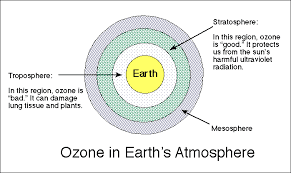Answers of Quiz 1765 (Ozone & Atmosphere)
1. On 16 September
2. Ozone is a pale blue gas with a distinctively pungent smell.
3. Trioxygen
4. O3
5. 48.00 g.mol
6. Oxygen (O2)
7. Ozone Layer is a region of Earth's stratosphere that absorbs most of the Sun's ultraviolet radiation.
8. The Ozone Layer is essential for human life. It is able to absorb much harmful ultraviolet radiation, preventing penetration to the earths surface. Ultraviolet radiation is defined as radiation with wavelengths between 290-320 nanometers, which are harmful to life because this radiation can enter cells & destroy the deoxyribonucleic acid (DNA) of many life forms on planet earth. In a sense, the ozone layer can be thought of as an ultraviolet filter or our planets built in sunscreen. Without the ozone layer, ultraviolet radiation would not be filtered as it reached the surface of the earth. If this happened, cancer would break out & all of the living civilizations, & all species on earth would be in jeopardy.
9. Ozone occurs in two layers of the atmosphere. The Ozone that is commonly associated with Ozone depletion & the Ozone hole is in the stratosphere. This good Ozone shields life on earth from the sun's harmful ultraviolet rays. Good Ozone is also called stratospheric ozone. About 80-90% of all Ozone in the atmosphere is found in the stratosphere.
10. The layer surrounding the earth's surface is the troposphere. Here, ground-level or bad ozone is an air pollutant that damages human health, vegetation, & many common materials. It is a key ingredient of urban smog. Bad Ozone is also called the tropospheric ozone.
11. The main cause for the depletion of ozone is determined as excessive release of chlorine & bromine & their compounds.
12. Atmosphere is the layer of gases surrounding the earth.
13. Atmosphere is composed of 78.08% Nitrogen, 20.95% Oxygen, 0.93% Argon, 0.038% Carbon Dioxide, & traces of Hydrogen, Helium, & other noble gases & a variable amount of water vapour on average about 1% at sea level.
14. 6 layers
15. Troposphere [starts at earths surface & extends 8 to 14.5 Km high (5 to 9 miles)]
16. Stratosphere [extends to 50 Km (31 miles)]
17. Mesosphere [extends to 85 Km (53 miles)]
18. Thermosphere [extends to 600 Km (372 miles)]
19. Ionosphere [48 Km (30 miles) above the surface to the edge of space at about 965 Km (600 miles)]
20. Exosphere [upto 10,000 Km (6,200 miles)]
21. Atmospheric Pressure is the force per unit area that is applied perpendicularly to a surface by the surrounding gas. It is measured with a barometer.
2. Ozone is a pale blue gas with a distinctively pungent smell.
3. Trioxygen
4. O3
5. 48.00 g.mol
6. Oxygen (O2)
7. Ozone Layer is a region of Earth's stratosphere that absorbs most of the Sun's ultraviolet radiation.
8. The Ozone Layer is essential for human life. It is able to absorb much harmful ultraviolet radiation, preventing penetration to the earths surface. Ultraviolet radiation is defined as radiation with wavelengths between 290-320 nanometers, which are harmful to life because this radiation can enter cells & destroy the deoxyribonucleic acid (DNA) of many life forms on planet earth. In a sense, the ozone layer can be thought of as an ultraviolet filter or our planets built in sunscreen. Without the ozone layer, ultraviolet radiation would not be filtered as it reached the surface of the earth. If this happened, cancer would break out & all of the living civilizations, & all species on earth would be in jeopardy.
9. Ozone occurs in two layers of the atmosphere. The Ozone that is commonly associated with Ozone depletion & the Ozone hole is in the stratosphere. This good Ozone shields life on earth from the sun's harmful ultraviolet rays. Good Ozone is also called stratospheric ozone. About 80-90% of all Ozone in the atmosphere is found in the stratosphere.
10. The layer surrounding the earth's surface is the troposphere. Here, ground-level or bad ozone is an air pollutant that damages human health, vegetation, & many common materials. It is a key ingredient of urban smog. Bad Ozone is also called the tropospheric ozone.
11. The main cause for the depletion of ozone is determined as excessive release of chlorine & bromine & their compounds.
12. Atmosphere is the layer of gases surrounding the earth.
13. Atmosphere is composed of 78.08% Nitrogen, 20.95% Oxygen, 0.93% Argon, 0.038% Carbon Dioxide, & traces of Hydrogen, Helium, & other noble gases & a variable amount of water vapour on average about 1% at sea level.
14. 6 layers
15. Troposphere [starts at earths surface & extends 8 to 14.5 Km high (5 to 9 miles)]
16. Stratosphere [extends to 50 Km (31 miles)]
17. Mesosphere [extends to 85 Km (53 miles)]
18. Thermosphere [extends to 600 Km (372 miles)]
19. Ionosphere [48 Km (30 miles) above the surface to the edge of space at about 965 Km (600 miles)]
20. Exosphere [upto 10,000 Km (6,200 miles)]
21. Atmospheric Pressure is the force per unit area that is applied perpendicularly to a surface by the surrounding gas. It is measured with a barometer.




Comments
Post a Comment